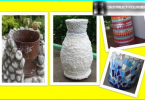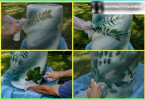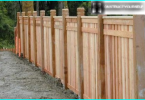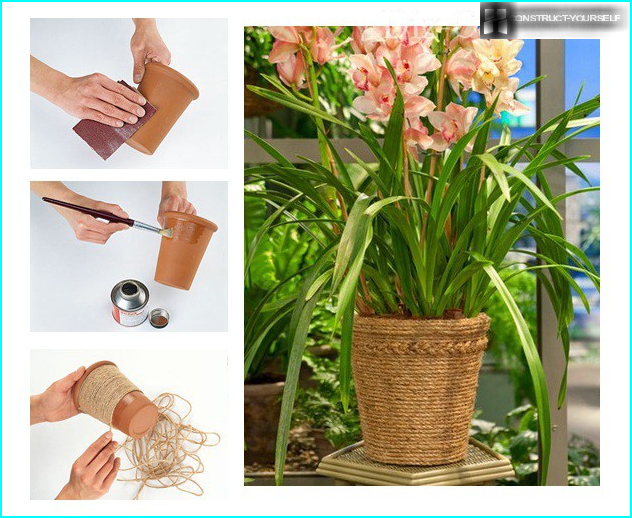
To the flower pots Housewives private plots have long been accustomed to and know how to put them songs on the site. But street vases are used in the private design is quite rare, as their elegance and luxurious look does not always fit into the village landscape. Once the vases were considered the prerogative of the Royal courts, as they were too expensive. But today, this stylish element of decor, outdoor living can be seen in city parks, near office buildings etc. we will Understand more, some vases today released to the streets, as you can use them to create emphasis on the plot and try to make an unusual vase with their hands.
The contents
Street vase today: types and materials
Unlike flower pot, vase has a special decorative effect due to the unusual shape. It is of two types:
- on the leg or pedestal;
- in the form of an elongated vessel up.
This design raises the vase above the ground and focuses on the top, highlighting it among the grass and flower beds. In most vases used as a specimen planting in them the most striking and vibrant plants.
High marble vases, set on the border of the lawn, visually lengthen the area and divide the space portion into several zones
British vases
The form on the foot is also called a urn, Cup or vase by the British, as it is in the English garden, this decor met most often. Today the shape of the Cup is slightly different from its predecessors restrained decor.
There is an abundance of stucco, of figures and of the carved flowers of the ornament, which was richly decorated vases of the Baroque era. And all because in this form, the vase does not fit into the modern landscape styles created in small areas. Luxurious decor is appropriate only in a huge Park and Palace complexes, but not for 5-10 acres of land.
Therefore, modern manufacturers focus on materials and unusual shape of the bowl, no clutter decor. Most of these containers are cast from plaster, concrete, fiberglass and plastic. People with high income purchase vases from a natural stone.
Use richly decorated with reliefs and sculptures of the British vases you need just as the tapeworms, having them away from the lush flower beds
Rich texture of natural stone is the main decoration, so these vases urns do not decorate with ornaments and stucco, and carefully polished to give Shine
Greek style
From the era of Ancient Greece we got floor vases, resembling huge vessels with handles or without, with a wide neck and narrow. Street options rarely fill with live plants, as it is problematic to change the land and care for the root system.
They are usually put on the dais to focus on a specific area, or fill with dried flowers and feature terraces, flower beds, near arches, pergolas.
On a green background weaving plant Greek vase looks very impressive, as it immediately attracts the eye
Vase in the style of hi-tech and minimalism
In the twentieth century floor vase acquired austere design and the correct geometry. No drawings – just clean lines and bold materials: metal, wire, plastic, glass, concrete.
In street landscape look good cubic, pyramidal and round vessels. Typically, these vases are painted in monocolor or two in contrast: black and white, black and red etc.
Tall rectangular vase with growing boxwood in them may be a good option of separating the fruit garden or garden area
How to use vase in a landscape design
Each type of decorative vessel is designed for a specific landscape style. If this is not taken into account, even the most luxurious vase will look on the plot of alien element.
Classic styles
British vases advantageous to use in the gardens of regular and landscape styles, Mediterranean landscape.
The Mediterranean style garden involves the creation of a closed from prying eyes zones. And British vase on the pedestal will perfectly fit into this landscape
Tips on placing British VAZ:
- A vase on a low stem with a wide bowl put as a solitaire in a secret corner of the garden (preferably on a pedestal), at the intersection of paths or by the garden bench.
- If leg high, and the bowl is a small diameter, they can be put facing each other, combining together a certain area. For example, the beginning and the end of the Central track. This technique is called «Alleyne». Most appropriate for large areas, not cluttered by small sculptural forms and structures.
- Some bowls can be placed in a circle, highlighting thus the front part of the plot in the center of which can be seen a fountain, gazebo or swing.
- A line along the hedge. Special effect is a combination of white or gray bowls full of colourful plants (petunias, marigolds), with a green background of the hedge. Land for vases pour pebbles.
By the way, please note that in winter, the British luxurious look of a vase filled with pine branches. For our snow country, this is true.
The installation of British bowls on the legs opposite each other at the corners of a certain area unites the space, giving the landscape perfection
Eastern and Italian gardens
Vases-vessels successfully fit into the interior of the Italian garden, in fact where they came from. But note that today the Italian style adheres to strict symmetry and geometric, which was not in the era of the ancient Greeks. So the vases in Italy come in pairs, for example, at the entrance to the gazebo near the fountain, on the steps of the terrace.
Where to put a vase in the Oriental garden:
- At the entrance to the garden (always with flowers as the entrance symbolized the gate to heaven).
- If the paths in the garden divide the area into squares, then put the pot in the center of 2-3 of the squares located far from each other.
- Along the shoreline of a stream or fountain flowing in the pond.
- On both sides of the wall fountain.
Eastern styles are also used vases-vessels, since the shape of the Greek vase is quite similar to the Chinese. But if Italy are welcome restrained natural colors (grey, white, brick), the East tends towards brightness. The vessels can be decorated with mosaics, painted three or more colors, creating intricate patterns.
Bowl filled with colored stones, in the Muslim garden can become the center of the courtyard, emphasizing the symmetry and strict forms of the composition
Modern + industrial styles
Modern styles use a vase, invented only in the twentieth century (not earlier!).
High-tech you can fill a huge number of cubes, pyramids and other original forms of vessels. The main thing – that they were all created from the same material.
The solidity of the concrete pedestal, the strict geometric lines and low plants in the bowl – all signs of a modern vase in the spirit of high-tech
Minimalism just 2-3 original vases, arranged in a specific rhythm. But if the vessel is of impressive size, not more than one. Composition, usually placed on the lawn, and a single instance in front of it or at the beginning of the front walkway.
Industrial style vase used as a specimen. It put so, to be able to observe not only from all sides of the site, but from the Windows of the house. The design of the vessel, must be unusually, unusually large, and the material – wire, metal (rusty can). Low vase set on a pedestal of bricks.
Eclectic and country
Rare the owner maintains the landscape in a simple style. Usually the backyard is a mixture of styles (eclecticism). And in this landscape you can use any kind of vase, if it is in harmony with the rest of the decor of a particular area, or to create something original with your hands.
By the way, the vase-handmade very relevant and rustic styles, where the entire landscape emphasizes the imagination of the owner and is not limited by stylistic traditions. In these gardens the best «root» cheap plastic vases, vessels, carved from wood, woven bowls. Do not use them empty and fill with fresh flowers, snags, reeds, etc. However, in winter, the decor will have to be removed, because wood and plastic have no frost, and temperature drop will burst, or get out.
In the gardens of rustic vases are put in a chaotic order, fill them full of colourful flowers planted in a few tiers
Rustic vases styles are always part of the composition, mingling with flowers and ornamental shrubs, animal figures or fairytale characters. They help to create a tiered flower bed, the pedestal often hides in stunted plants. The décor vases can be quite modest, wood and concrete is not dyed and retain their natural texture.
Master classes on making homemade vases
To purchase a decorative vase of the desired design and size it is not always possible, because this craft involved a few people. And design of natural stone and concrete like the road. But a striking element of the landscape you can create with your own hands, and very easy way.
Consider three options for homemade vases.
Method #1 — vase from the cloth and concrete
If you have never dealt with the creation of the WHA or at least some of the sculptural forms – start with this vase. It is made from old rags – knitted sweater, wool coarse cloth or burlap. In short, find the thing that lost the spectacular view – and in the case.
Unusually striking design and ease of creation of vases from the seeds provided them with high popularity among gardeners and owners of private houses
The technology of creating vases out of old curtains or skirts so simple and straightforward that it can test on your site any layman
To work please be:
- old bucket;
- cement grade 500;
- jar «FAE» for washing dishes (used as plasticizer);
- a pair of rubber gloves.
Step by step instructions:
- The old bucket turn upside down and put on the platform (pedestal, beam etc) in a shady place. Bottom land, close the cardboard or plastic that the flowing concrete does not spoil the landscape.
- Fit for fitting on the bucket, the rag, which will create a vase. It is necessary that the edges of the canvas freely fitting capacity, forming folds and without impediment from the bottom. Decide on the shape of a vase from (asymmetric, with a beveled edge, etc.), because after solidification it will not change.
- Dissolve in a basin of cement with water to the consistency of thick cream, pour a little «FAE» (in a bucket of concrete tsp funds) and mix.
- Immerse in a solution of a duster, let her have the concrete.
- Brush with vegetable oil on outer surface of the bucket to form to it is not stuck.
- Remove the soaked concrete material and, without squeezing, put into a bucket, giving the shape of a vase, which was defined in advance.
- Within 3 days the vase to dry. Periodically (2-3 days) sprinkle it with water so the concrete Mor gradually. This will improve the frost resistance of the product.
- After 3 days remove from under the vase bucket, and the product itself flip the bottom down and put on a week under the canopy process to continue.
- The finished vase is coated with primer to reduce the porosity, paint with acrylic paints or decorated with varnish for exterior use on concrete and stone.
If you still have after the installation works a piece of plastic pipe with large diameter, it is possible to decorate dipped in a cement material, positioning the tissue folds. The product is very original in design and will fit in any garden in modern style.
Decorate old capacity material impregnated with a concrete solution, you will receive unusual and durable outdoor vase, which are not afraid of winter and rain
Method #2 — vase of fine gravel
It happens that the house was once bought a plastic vase which has lost its relevance and does not fit the new landscape. Give it a second life, decorate with gravel. And then it will acquire the features of a classic stone vase.
A vase of fine aggregate fits in any style, which relies on natural materials, so it is placed in the Eastern garden and in village
For this you will need:
- plastic vase;
- cement grade 500;
- sand fine fraction;
- «FAE»;
- fine gravel;
- screwdriver and screws;
- nylon thread or soft wire;
- gloves, trowel.
Progress:
- Across the surface of the plastic mould and screw the screws (tip inside), and driving of the cap is not close, but leaving a gap of 1-2 mm.
- Zapletal cap with nylon thread or wire, creating a frame that will hold the cement slurry.
- Knead the solution: 1:3 and while mixing add a little «FAE».
- With a trowel spread the mortar on the frame, starting from the bottom, and immediately pressed the stones, trying to arrange them tightly, the pitch is the same.
- Vase ready dried in the shade for 3-4 days.
- Decorate the surface with varnish.
Lucky for exterior use have a greater range of colors, so you will be able to make ready a vase right shade and also to protect it from moisture.
Instead «FAE» some masters added to the composition of a solution of PVA glue or Bustilat, to ensure the strength of the vase, but these plasticizers are more expensive
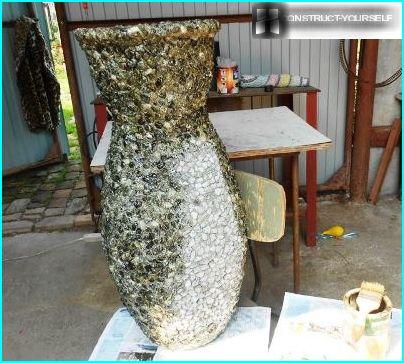
Method #3 — the vase of twigs and plastic pipe
For the country style you can create a vase from twigs. It will be of elongated cylindrical shape, since it is based on a plastic pipe. The decor will need burlap and smooth thin dried branches of a tree. They are easy to find on the clearing in the woods.
Vase decorated with small sprigs of trees, goes well with wicker fencing, furniture, cut down trees and Moorish lawn
Progress:
- Harvested in the forest twigs of the correct length and thickness. Their length should be greater than the pipe-the basics 5-7 cm.
- Plastic pipe cut to desired height.
- They are driving inside a round stone to he lay on the bottom, but not dropped. This will give the structure stability in the wind.
- Wind the outer surface of the pipe with burlap, bending the ends inside the pipe and fixing them on with liquid nails. Special flatness is not necessary, since the fabric will cover branches.
- Jute thread or twine connect the branches into one, linking them together with a simple knot. If the vase is low enough to knit the top and bottom. If more than one meter, then tie the branches in the middle third thread.
- Try on the wooden frame on the pipe until it covers it completely.
- Fix the branch pipe a thick decorative rope.
To prolong the service life, wooden vase is better for the winter clean up in the room.
If the vase will stand under the open sky, to protect from moisture, you can soak the burlap with vegetable oil, and the branches to varnish
Method #4 — vase of gypsum
For this variant we have for you a video instruction:
Based on the workshops has been to create original elements of the garden decor, and all the vases are unique. The main thing — do not overdo the amount, otherwise the landscape will lose the natural look and harmony of.

